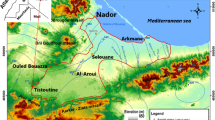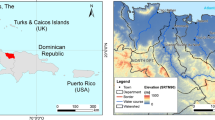Abstract
The Pampa del Tamarugal Aquifer (PTA) is an important source of groundwater in northern Chile. In this study, a groundwater flow model of this aquifer is developed and calibrated for the period 1983–2004. The model reproduces the observed flow-field and the water balance components reasonably well. Five scenarios are defined to evaluate the response to different pumping situations. These scenarios show that groundwater heads will continue to decrease with the present pumping discharge rates. To account for variations in the model results due to uncertainties in average recharge rates, randomly generated recharge realizations with different levels of uncertainty are simulated. Evaporation flow rates and groundwater flowing out of the modelled area seem unaffected by the recharge uncertainty, whereas the storage terms can vary considerably. For the most intensive pumping scenario under the generated random recharge rates, it is unlikely that the cumulative discharged volume from the aquifer, at the end of the simulation period, will be larger than 12% of the estimated groundwater reserve. Fluctuations in simulated groundwater heads due to uncertainties in the average recharge values are more noticeable in certain areas. These fluctuations could explain unusual behaviour in the observed groundwater heads in these areas.
Résumé
L’aquifère de la Pampa del Tamarugal (PTA) représente une importante source d’eau souterraine dans le Nord du Chili. Dans cette étude, un modèle d’écoulement souterrain de cet aquifère est réalisé et calibré pour la période 1983–2004. Celui-ci reproduit le champs d’écoulement observé et les composantes du bilan d’eau raisonnablement bien. Cinq scénarios sont définis pour évaluer la réponse du système à des conditions de pompage différentes. D’après ces scénarios, les niveaux piézomètriques vont continuer à baisser sous l’effet des taux de pompage actuels. Pour tenir compte de la variabilité des résultats du modèle due aux incertitudes sur les taux de recharge moyens, des épisodes de recharge, générés aléatoirement et présentant différents niveaux d’incertitude sont simulés. Les taux d’évaporation et l’eau souterraine s’écoulant hors de la zone modélisée semblent non affectés par l’incertitude sur la recharge, les termes d’emmagasinement en revanche peuvent varier considérablement. Dans le cas du scénario avec le pompage le plus important et des taux de recharge aléatoires, il est peu probable que le volume cumulé pompé hors de l’aquifère à la fin de la simulation atteigne une valeur supérieure à 12% de la réserve d’eau souterraine estimée. Les fluctuations des niveaux piézomètriques simulés liées aux incertitudes sur les recharges moyennes sont plus perceptibles dans certaines zones. Ces fluctuations pourraient expliquer un comportement inhabituel des niveaux piézomètriques observés dans ces zones.
Resumen
El Acuífero de la Pampa del Tamarugal (PTA) es una fuente importante de agua subterránea en el norte de Chile. En este estudio se desarrolla y calibra un modelo de flujo de agua subterránea para el periodo 1983–2004. El modelo reproduce razonablemente bien el campo de flujo observado y los componentes del balance hídrico. Se definen cinco escenarios para evaluar la respuesta a diferentes situaciones de bombeo. Estos escenarios muestran que con las tasas de descarga de bombeo actuales las presiones de agua subterránea continuarán en descenso. Para explicar las variaciones en los resultados del modelo debidas a incertidumbres en tasas de recarga promedio se han simulado realizaciones de recarga generadas aleatoriamente con diferentes niveles de incertidumbre. Las tasa de flujo por evaporación y el agua subterránea que fluye fuera del área modelizada parecen no haber sido afectadas por la incertidumbre en recarga mientras que los términos de almacenamiento pueden variar considerablemente. Para el escenario de bombeo más intenso, bajo las tasas de recarga generadas aleatoriamente, no es probable que el volumen descargado acumulado del acuífero al final del periodo de simulación sea mayor del 12% de la reserva de agua subterránea estimada. Las fluctuaciones en las presiones simuladas de agua subterránea debido a las incertidumbres en los valores de recarga promedio son más notorios en ciertas áreas. Las fluctuaciones podrían explicar el comportamiento inusual en las presiones de agua subterránea observadas en estas áreas.












Similar content being viewed by others
References
Aravena R (1995) Isotope hydrology and geochemistry of northern Chile groundwaters. Bull Inst Français Études Andines 24(3):495–503
Arrau F (1998) Distribución y comercialización de las aguas en Chile [Water distribution and commercialization in Chile]. Study Series No. 178, The Library of the National Congress, Santiago, Chile
Brown E (2003) Uso eficiente del recurso hídrico [Efficient use of the water resource]. In: National Workshop of Chile, Towards a national plan of integrated water resources management CEPAL, Chile. December 2003, CEPAL/GWP-SAMTAC, Santiago, Chile, pp 22
Doherty J, Brebber L, Whyte P (1994) PEST: Model-independent parameter estimation. User’s manual. Watermark Computing, Corinda, Australia
Digert F, Hoke G, Jordan T, Isacks B (2003) Subsurface stratigraphy of the neogene Pampa del Tamarugal basin, northern Chile. X Congreso Geológico Chileno, Concepción, Chile, October 2003, pp 8
Dingman R, Galli C (1965) Geology and groundwater resources of the Pica area, Tarapaca Province, Chile. Bull United States Geological Survey No. 1189, USGS, Reston, VA
Dirección General de Aguas–DGA (1987) Balance hídrico de Chile [Water balance of Chile]. Technical Report–Digital data, Centro de Información de Recursos Hídricos, Dirección General de Aguas, Ministerio de Obras Públicas, Santiago, Chile
Dirección General de Aguas–DGA (1996) Determinación de la disponibilidad de recursos hídricos para constituir nuevos derechos de aprovechamiento de aguas subterráneas en el sector del acuífero de la Pampa del Tamarugal [Determination of water resources availability for granting new groundwater rights in the area of the Pampa del Tamarugal aquifer]. Technical report S.D.T. No. 68, Centro de Información de Recursos Hídricos, Dirección General de Aguas, Ministerio de Obras Públicas, Santiago, Chile, pp 27
Dirección General de Aguas–Comisión Chilena de Energía Nuclear–DGA-CCHEN (1998) Aplicación de técnicas hidrológicas no convencionales en zonas áridas y semiáridas. Evaluación de recursos hídricos en el sector de Pica, Hoya de la Pampa del Tamarugal, I Región [Application of non-conventional hydrological techniques in arid and semi-arid zones. Water resources evaluation in Pica area, Pampa del Tamarugal basin, I Region]. Technical report S.I.T. No. 48, Centro de Información de Recursos Hídricos, Dirección General de Aguas, Ministerio de Obras Públicas, Santiago, Chile, pp 101
Dirección General de Aguas–Universidad de Chile-DGA-UChile (1988) Modelo de simulación hidrogeológico de la Pampa del Tamarugal [Hydrogeological simulation model of the Pampa del Tamarugal]. Technical Report, Centro de Información de Recursos Hídricos, Dirección General de Aguas, Ministerio de Obras Públicas, Santiago, Chile, pp 98
Dirección de Investigaciones Científicas y Tecnológicas Universidad Católica de Chile–DICTUC (2005) Análisis técnico de solicitud de derechos de aprovechamiento de ACF minera [Technical analysis of the groundwater rights request of mining company ACF] Technical report, Dirección de Investigaciones Científicas y Tecnológicas Universidad Católica de Chile, Santiago, Chile, pp 107
Food and Agriculture Organization–FAO (1989) Role of Forestry in combating desertification. FAO Conservation Guide 21, Food and Agriculture Organization of the United Nations, Rome
Grilli A, Vidal F, Garín C (1986) Balance hidrológico nacional, I Región [National hydrologic balance, I Region]. Dirección General de Aguas. Technical Report EH/86/2, Centro de Información de Recursos Hídricos, Dirección General de Aguas, Ministerio de Obras Públicas, Santiago, Chile, pp 20
Grilli A, Aguirre E, Duran M, Townsend F, Gonzales A (1999) Origen de las aguas subterráneas del sector Pica-Salar del Huasco, Provincia de Iquique, I Región de Tarapaca [Origin of the groundwater in the sector of Pica-Salar del Huasco, Province of Iquique, I Region of Tarapacá]. In: AIDIS-CHILE Congress, Capítulo chileno Asociación Interamericana de Ingeniería Sanitaria y Ambiental, Santiago, Chile, pp 18
Houston J (2002) Groundwater recharge through an alluvial fan in the Atacama Desert, northern Chile: mechanisms, magnitudes and causes. Hydrol Process 16:3019–3035
Japanese International Cooperation Agency, Dirección General de Aguas, Pacific Consultants International (JICA-DGA-PCI) (1995) The study on the development of Water Resources in northern Chile. Technical reports. Supporting reports B and C, Centro de Información de Recursos Hídricos, Dirección General de Aguas, Ministerio de Obras Públicas, Santiago, Chile, pp 259
Margaritz M, Aravena R, Peña H, Suzuki O, Grilli A (1990) Source of groundwaters in the deserts of northern Chile: evidence for deep circulation of groundwaters from the Andes. Ground Water 28:523–517
McDonald M, Harbaugh A (1988) A modular three-dimensional finite-difference groundwater flow model. USGS Technical Report on Modelling Techniques Book 6, USGS, Reston, VA, pp 596
Risacher F, Alonso H, Salazar C (1998) Geoquímica de aguas en cuencas cerradas I, II y III regiones–Chile [Water geochemistry in closed basins I, II and III regions–Chile]. Technical Report DGA-UCN-ORSTOM, Centro de Información de Recursos Hídricos, Dirección General de Aguas, Ministerio de Obras Públicas, Santiago, Chile, pp 84
Rojas R (2005) Groundwater flow model of Pampa del Tamarugal Aquifer–Northern Chile. MSc Thesis Water Resources Engineering. Katholieke Universiteit Leuven and Vrije Universiteit Brussel, Belgium, pp 103
Acknowledgements
The authors wish to thank to the Dirección General de Aguas, Chile for providing all the necessary information for the development of this study. Also, the comments of two anonymous reviewers are greatly appreciated for improving the original manuscript.
Author information
Authors and Affiliations
Corresponding author
Rights and permissions
About this article
Cite this article
Rojas, R., Dassargues, A. Groundwater flow modelling of the regional aquifer of the Pampa del Tamarugal, northern Chile. Hydrogeol J 15, 537–551 (2007). https://doi.org/10.1007/s10040-006-0084-6
Received:
Accepted:
Published:
Issue Date:
DOI: https://doi.org/10.1007/s10040-006-0084-6




